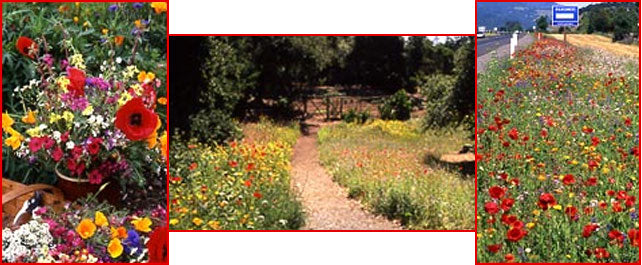To Place An Order, please choose from any of our mixes... and more... from the dropdown menu above.
Any of our mixtures can be planted in the fall or early spring, anywhere in North America. In the milder climates of the far west and south, fall is the preferred planting time, allowing the wildflowers to take advantage of the winter growing season. In areas with colder winters, you'll have the greatest success with early spring plantings after the last frost. The following wildflower planting instructions are reprinted from an article which appeared in Sunset magazine:
"The most common mistake when planting wildflower seeds is not getting rid of the existing weed and native grass seeds that are in the soil and germinate along with the wildflowers", says Michael Landis, president of the Wildflower Seed and Tool Company in St. Helena."These fast-growing weeds and grasses smother out the slower-growing wildflowers."
For a more successful planting, Landis recommends that gardeners take time to eliminate the competition.
"First, choose a site in full sun. To get rid of existing weeds, hand-cultivate the soil to a depth of 3 or 4 inches and remove all weeds; this is the method with the least environmental impact. You can also spray weeds with an herbicide, such as glyphosate, and then cultivate the soil to a depth of not more than 1 inch; deeper cultivation exposes more weed seeds that will germinate along with wildflower seeds. Before sowing the wildflower seeds, rake the soil to form shallow grooves. To ensure even distribution of seed, mix with four times its volume of sand or vermiculite and broadcast by hand. Then rake the seed lightly into the soil and tamp it for good soil contact. If rains don't come, water to keep the soil moist and continue watering through bloomtime. When the plants have dried and dropped their seed, cut old stalks to 3 to 6 inches high".
